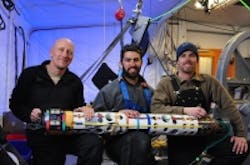Page 2: Vision-guided underwater robot discovers sea anemones living in ice
The species of white anemones— named Edwardsiella andrillae–were burrowing into the underside of the ice, were discovered by SCINI in 2010, but were only publicly identified for the first time in a recent article in PLOS ONE.They are the first species identified known to live in ice, and also live upside down, hanging from the ice, compared to other sea anemones that live on or in the sea floor.
ANDRILL’s Coulman High Project was financed by the National Science Foundation in the U.S. and the New Zealand Foundation for Research. It was deployed to learn more about the ocean currents beneath the ice shelf and to provide environmental data for modeling the behavior of the ANDRILL drill string, so the discovery of a new species came as a surprise to the team.
"They had found a whole new ecosystem that no one had ever seen before," Rack said in a UNL press release. "What started out as an engineering test of the remotely operated vehicle during its first deployment through a thick ice shelf, turned into a significant and exciting biological discovery."
Plans for a project called Deep-SCINI are underway, which involves the further study of this environment using a robot to explorer deeper into the ocean (up to 1000m, compared to SCINI’s 300m limit). NASA, which is interested in microbiology and the possibility of identifying potential habitats using remote sensing capabilities, is helping to finance the project.
View the UNL press release.
Also check out:
Underwater robots search for World War II pilots, aircraft
Vision-enabled subs will search for alien life
(Slideshow) 10 innovative current and future robotic applications
Share your vision-related news by contacting James Carroll, Senior Web Editor, Vision Systems Design
To receive news like this in your inbox, click here.
Join our LinkedIn group | Like us on Facebook | Follow us on Twitter | Check us out on Google +
Page 1 | Page 2
About the Author

James Carroll
Former VSD Editor James Carroll joined the team 2013. Carroll covered machine vision and imaging from numerous angles, including application stories, industry news, market updates, and new products. In addition to writing and editing articles, Carroll managed the Innovators Awards program and webcasts.

